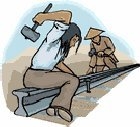
Worksheets and No Prep Teaching Resources
Reading Comprehension Worksheets
The United States Grows
(1865-1900)

The United States Grows
(1865-1900)
 Worksheets and No Prep Teaching Resources Reading Comprehension Worksheets The United States Grows (1865-1900) |
 The United States Grows (1865-1900) |
| edHelper's suggested reading level: | grades 6 to 8 | |
| Flesch-Kincaid grade level: | 6.59 |
|
Cable Cars
By Sharon Fabian |

|
 1 If you ever travel to San Francisco, you can take a ride on a cable car. These colorful vehicles, which look a little bit like passenger train cars, carry riders up and down San Francisco's steep hills. People from all over the world make sure to take a ride on a San Francisco cable car when they visit California.
1 If you ever travel to San Francisco, you can take a ride on a cable car. These colorful vehicles, which look a little bit like passenger train cars, carry riders up and down San Francisco's steep hills. People from all over the world make sure to take a ride on a San Francisco cable car when they visit California. |
Create Weekly Reading Books
Prepare for an entire week at once! |
| Leave your feedback on Cable Cars (use this link if you found an error in the story) |
 |
The United States Grows (1865-1900) |
 |
United States
|
|
|
 | Fifty States Theme Unit |
 |
Document Based Activities |